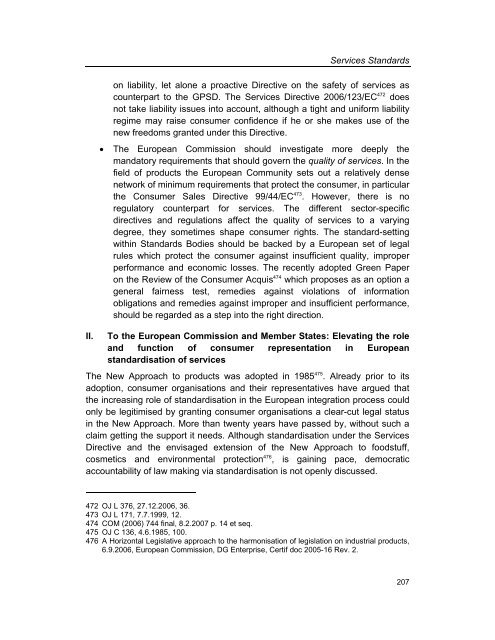Services Standards: Defining the Core Consumer Elements ... - ANEC
Services Standards: Defining the Core Consumer Elements ... - ANEC
Services Standards: Defining the Core Consumer Elements ... - ANEC
Create successful ePaper yourself
Turn your PDF publications into a flip-book with our unique Google optimized e-Paper software.
II.<br />
<strong>Services</strong> <strong>Standards</strong><br />
on liability, let alone a proactive Directive on <strong>the</strong> safety of services as<br />
counterpart to <strong>the</strong> GPSD. The <strong>Services</strong> Directive 2006/123/EC 472 does<br />
not take liability issues into account, although a tight and uniform liability<br />
regime may raise consumer confidence if he or she makes use of <strong>the</strong><br />
new freedoms granted under this Directive.<br />
• The European Commission should investigate more deeply <strong>the</strong><br />
mandatory requirements that should govern <strong>the</strong> quality of services. In <strong>the</strong><br />
field of products <strong>the</strong> European Community sets out a relatively dense<br />
network of minimum requirements that protect <strong>the</strong> consumer, in particular<br />
<strong>the</strong> <strong>Consumer</strong> Sales Directive 99/44/EC 473 . However, <strong>the</strong>re is no<br />
regulatory counterpart for services. The different sector-specific<br />
directives and regulations affect <strong>the</strong> quality of services to a varying<br />
degree, <strong>the</strong>y sometimes shape consumer rights. The standard-setting<br />
within <strong>Standards</strong> Bodies should be backed by a European set of legal<br />
rules which protect <strong>the</strong> consumer against insufficient quality, improper<br />
performance and economic losses. The recently adopted Green Paper<br />
on <strong>the</strong> Review of <strong>the</strong> <strong>Consumer</strong> Acquis 474 which proposes as an option a<br />
general fairness test, remedies against violations of information<br />
obligations and remedies against improper and insufficient performance,<br />
should be regarded as a step into <strong>the</strong> right direction.<br />
To <strong>the</strong> European Commission and Member States: Elevating <strong>the</strong> role<br />
and function of consumer representation in European<br />
standardisation of services<br />
The New Approach to products was adopted in 1985 475 . Already prior to its<br />
adoption, consumer organisations and <strong>the</strong>ir representatives have argued that<br />
<strong>the</strong> increasing role of standardisation in <strong>the</strong> European integration process could<br />
only be legitimised by granting consumer organisations a clear-cut legal status<br />
in <strong>the</strong> New Approach. More than twenty years have passed by, without such a<br />
claim getting <strong>the</strong> support it needs. Although standardisation under <strong>the</strong> <strong>Services</strong><br />
Directive and <strong>the</strong> envisaged extension of <strong>the</strong> New Approach to foodstuff,<br />
cosmetics and environmental protection 476 , is gaining pace, democratic<br />
accountability of law making via standardisation is not openly discussed.<br />
472 OJ L 376, 27.12.2006, 36.<br />
473 OJ L 171, 7.7.1999, 12.<br />
474 COM (2006) 744 final, 8.2.2007 p. 14 et seq.<br />
475 OJ C 136, 4.6.1985, 100.<br />
476 A Horizontal Legislative approach to <strong>the</strong> harmonisation of legislation on industrial products,<br />
6.9.2006, European Commission, DG Enterprise, Certif doc 2005-16 Rev. 2.<br />
207
















